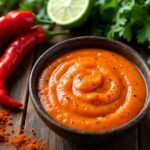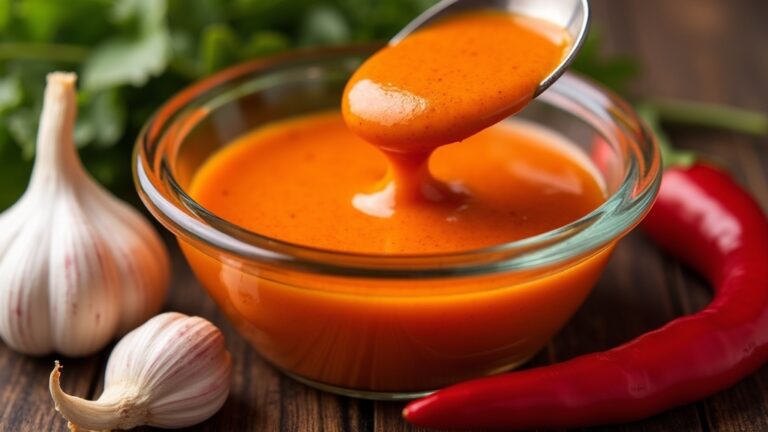Peanut Sauce Recipe
I love making peanut sauce because it’s creamy, rich, and adds incredible flavor to any dish. To whip up this delicious sauce, I mix 1 cup of creamy peanut butter, 1/4 cup of soy sauce, 2 tablespoons each of rice vinegar and honey, and 1/4 cup of warm water. Blending it all together gives me a smooth, customizable sauce perfect for dipping or drizzling. Stick around, and I’ll share more about its nutritional benefits and versatility!
Contents
History
When I think about the history of peanut sauce, I can’t help but feel a connection to its rich cultural roots. This sauce boasts ancient origins, tracing back to Southeast Asia, where it became a staple in various cuisines. It’s fascinating how this simple blend of peanuts, spices, and flavors evolved through time, embodying the culinary traditions of many cultures. Each region adds its unique twist, highlighting the sauce’s cultural significance. For many, it represents more than just a condiment; it’s a symbol of community and shared meals. As I explore its history, I’m inspired by how peanut sauce continues to innovate, bridging the gap between tradition and modern culinary creativity. It’s a true reflection of the power of food in connecting us all.
Recipe
Peanut sauce is a versatile and delicious addition to many dishes, especially in Asian cuisine. It’s creamy, rich, and packed with flavor, making it a perfect dip for fresh vegetables, a dressing for salads, or a sauce for noodles and grilled meats. The beauty of peanut sauce lies in its simplicity and the ability to customize it according to your taste preferences—whether you prefer it spicy, sweet, or tangy.
Making peanut sauce at home requires just a handful of ingredients that you may already have in your pantry. With a few easy steps, you can whip up this delightful sauce in no time. It’s perfect for meal prep, as it can be stored in the fridge for several days, allowing you to enjoy it on various dishes throughout the week.
Making peanut sauce at home is simple and quick, perfect for meal prep to enjoy throughout the week.
Ingredients:
- 1 cup creamy peanut butter
- 1/4 cup soy sauce
- 1/4 cup warm water
- 2 tablespoons rice vinegar
- 2 tablespoons honey or maple syrup
- 1 tablespoon sesame oil
- 1-2 teaspoons sriracha or chili paste (optional for heat)
- 1 clove garlic, minced
- 1 teaspoon grated fresh ginger (optional)
- Chopped peanuts and cilantro for garnish (optional)
To make the peanut sauce, start by mixing the creamy peanut butter, soy sauce, warm water, rice vinegar, honey or maple syrup, and sesame oil in a medium bowl. Whisk the ingredients together until smooth and well combined. If you prefer a spicier sauce, add sriracha or chili paste, along with the minced garlic and grated ginger. Continue to whisk until everything is fully blended and creamy. Adjust the consistency by adding more warm water if needed, and taste for seasoning, adjusting sweetness or saltiness to your liking.
When cooking peanut sauce, it’s important to remember that you can easily adjust the flavors to suit your preferences. If you like a thicker sauce, use less water; for a thinner sauce, add more warm water gradually. Additionally, this sauce can be stored in an airtight container in the refrigerator for up to a week. If the sauce thickens in the fridge, simply stir in a little warm water to reach your desired consistency before using. Don’t hesitate to experiment by adding different spices or herbs to create your signature peanut sauce!
Cooking Steps
Now that we’ve gathered all our ingredients, it’s time to bring them together in a delightful blend. I’ll show you how to achieve that perfect smooth consistency and adjust the flavors to your liking. Finally, we’ll finish it off with some fresh herbs for a vibrant touch that elevates the dish!
Step 1. Gather All Ingredients
Before diving into making the rich and flavorful peanut sauce, I always confirm I have all the necessary ingredients laid out. This not only streamlines the process but also sparks creativity in my kitchen. Here’s what I gather:
- Creamy peanut butter
- Soy sauce or tamari (for gluten-free options)
- Fresh lime juice
- Garlic (minced)
- Brown sugar or honey
Don’t hesitate to explore ingredient alternatives—like using almond butter for a nut-free version or adding sriracha for a spicy kick! As for preparation tips, measuring everything ahead of time guarantees a smoother cooking experience. With all these components ready, I’m set to create a sauce that elevates my dishes and impresses everyone at the table!
Step 2. Blend Ingredients Until Smooth
With all the ingredients ready, I plunge into the blending process to create a velvety peanut sauce. Using my trusty blender, I start with short bursts, allowing the ingredients to mingle and marry. I employ various blending techniques, like pulsing and mixing at different speeds, to guarantee that everything combines seamlessly. It’s fascinating to watch as the chunky pieces transform into a creamy concoction, showcasing smooth textures that are simply irresistible. I scrape down the sides occasionally, assuring every bit gets the attention it deserves. The aroma wafts through the kitchen, promising a burst of flavor. Once I achieve that perfect silkiness, I know I’m on my way to creating a sauce that’ll elevate any dish!
Step 3. Add Water for Consistency
As I blend the ingredients to perfection, I realize that achieving the right consistency for my peanut sauce is essential for the best flavor experience. Water consistency plays a vital role in determining the sauce thickness, and I often find that adding just the right amount of water transforms the texture beautifully. Here’s how I do it:
- Start with a small amount of water
- Blend thoroughly to check the thickness
- Add more water gradually for a smoother texture
- Adjust based on your desired consistency
- Remember, it’s easier to add than to take away!
With each addition, I can feel the sauce becoming silkier, ready to elevate my dish. Enjoy the process of innovation in your cooking!
Step 4. Taste and Adjust Seasoning
Once I’ve achieved the perfect consistency for my peanut sauce, it’s time to focus on the flavor. I start by tasting a spoonful, letting the creamy richness wash over my palate. I aim for that ideal flavor balance, where the nuttiness harmonizes with the sweetness, saltiness, and acidity. If it feels off, I reach for my seasoning adjustments. A splash of soy sauce can deepen the umami, while a dash of lime juice brightens everything up. If I crave more heat, a sprinkle of chili flakes does the trick. I keep tasting, tweaking, and experimenting until everything melds beautifully. This process transforms a simple sauce into a vibrant, mouthwatering experience that elevates any dish it accompanies.
Step 5. Serve With Fresh Herbs
Fresh herbs can elevate your peanut sauce to a whole new level. When I add them, I notice an incredible flavor enhancement that brightens every bite. Here’s how I like to serve my peanut sauce with fresh herbs:
- Cilantro: Its citrusy notes add a invigorating zing.
- Basil: Sweet basil offers a fragrant, aromatic touch.
- Mint: A sprinkle of mint creates a cooling effect.
- Green onions: They bring a subtle crunch and mild onion flavor.
- Thai basil: Its unique taste adds an exotic twist.
Nutritional Guide
While many people enjoy the rich, creamy flavor of peanut sauce, it’s essential to contemplate its nutritional profile. This sauce is not just a flavorful addition; it boasts impressive nutritional benefits. Packed with protein and healthy fats, it can elevate your meals while satisfying dietary considerations.
| Nutrient | Amount per 2 tbsp |
|---|---|
| Calories | 190 |
| Protein | 8g |
| Healthy Fats | 16g |
| Fiber | 2g |
This table illustrates how peanut sauce can be a powerhouse in your diet, enriching your dishes with essential nutrients. As you explore this culinary delight, remember that balance and moderation are key to enjoying its benefits while aligning with your health goals.
Final Thoughts
Peanut sauce isn’t just a delicious addition to your meals; it also offers great nutritional benefits that can enhance your overall diet. I’ve experimented with various peanut sauce variations, and I’m continually amazed by how versatile this sauce can be. Here are some compelling reasons to incorporate it into your meals:
Peanut sauce adds flavor and nutrition to meals, making it a versatile and healthy choice for any diet.
- Packed with protein and healthy fats
- Contains essential vitamins and minerals
- Supports heart health and boosts energy
- Can be easily customized with spices and flavors
- Pairs well with a variety of dishes, from salads to noodles
Frequently Asked Questions
Can I Use Crunchy Peanut Butter Instead of Smooth?
I love using crunchy peanut butter! It adds a delightful crunch and unique flavor difference that really elevates dishes. If you’re feeling adventurous, go for it—your taste buds will appreciate the innovative twist!
How Long Can I Store Homemade Peanut Sauce?
I’ve found that homemade storage for peanut sauce is best in the fridge, where it lasts about a week. For ideal flavor, use it fresh, but it’s still good for about a week’s shelf life!
Is Peanut Sauce Suitable for Vegan Diets?
Absolutely, peanut sauce fits perfectly into a vegan diet! With ingredients like peanuts and soy sauce, it’s packed with flavor and nutrients. The benefits of a vegan diet shine through in every delicious bite!
What Dishes Pair Well With Peanut Sauce?
I love pairing peanut sauce with Thai noodles, Asian salads, and spring rolls. It elevates satay skewers, veggie stir fry, and grilled chicken too. Don’t forget to drizzle it over rice or Buddha bowls!
Can I Freeze Peanut Sauce for Later Use?
When it comes to freezing sauces, I’ve found it’s essential to take into account sauce consistency. I use airtight containers and proper freezing methods, ensuring it stays delicious for later use. Just remember, thawing can alter texture!
Conclusion
As I drizzle the creamy, golden peanut sauce over a vibrant stir-fry, the aroma envelops me like a warm embrace. Each bite bursts with a harmony of flavors, reminding me of the rich history behind this beloved sauce. It’s more than just a recipe; it’s a journey through time and taste. So, whether you’re dipping, dressing, or marinating, let this peanut sauce bring a touch of delight to your meals, transforming the ordinary into something extraordinary.






